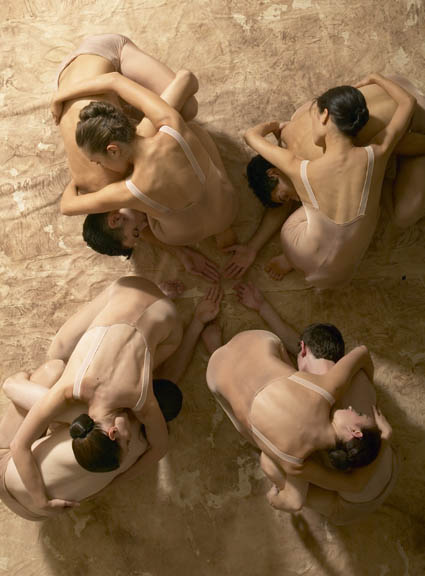Feeding on Human Beauty: Minnesota Dance Theater
Lightsey Darst saw the Minnesota Dance Theatre performance featuring the choreography of Wynn Fricke: Widening the Circle, at the OShaughnessy Auditorium. Sometimes topical, always effective, it was a show worth seeing.

Six dancers stand at attention at the back of the stage, wearing combat boots and army green. Another dancer stands at the front of the stage, shirtless, mining a weapon as the United States Marine Rifleman’s Creed is read aloud, while behind him his antagonist waits. The dancers breathe—gut-heaving exhalations—to provide a rhythmic background; then echoing bagpipes take over.
The military theme of Wynn Fricke’s “Lament” might drag into travesty, but Fricke is smarter and purer of purpose than that. The surprisingly poetic creed, read at the beginning, starts a seed in the audience’s mind: that though war is a horror, the men and women who fight it are honorable, and they, like artists, train daily to be better—more physically fit, yes, but also braver, wiser, more responsible.
The soldier at the front of the stage (Samuel Feipel) and his double at the back (Nick Strafaccia) slowly begin to dance together, winding, leaping, lifting and pushing each other, the light shining on their bodies. Without warning they speed up, and what was dance and caress becomes battle. With this simple dance, Fricke puts the loss before you: that such training, such nobility, should go into killing and dying, that this nobility lives on both sides of the fighting, that war feeds on human beauty.
Fricke’s “Two Fridas” takes an entirely different subject—the broken life of Frida Kahlo, her ambition and passion bound by her time, her body—but with the same sure purpose. One Frida—Mary Ann Bradley—is earthbound, strong, and desperate, the real woman, the living and dying woman, while the other—Jennifer Hart—is ethereal, weak, and dreamy, the artist, the one who must be born and borne up. Sometimes Hart winds around Bradley in seeming levitation, Bradley lifting her without strain, without holding her; sometimes their encounter is ritual combat, one needing to suffer for the life of the other. Hart reaches out from between Bradley’s legs and Bradley yanks her forward into the world, her unwelcome but necessary child.
Freed for a moment from her burden, Bradley leaps while her other half lies crumpled on the stage. Later, the two women sit on the bench, apart, and you want them to reconcile, but this would not be true, and Fricke ends the dance in fatal separation. Here, as in “Lament,” Fricke isn’t telling a story through dance, translating an idea into dance, but finding the dance at the center of the moment. “Lament” and “Two Fridas” are disturbing, shapeless dances—shapeless and disturbing as life. Devoid of artifice, pretense, or humor, the dances go like arrows. They are wounding, and the wound cannot be translated.
Fricke’s “Upturned Jewel” (a premier, as is “Lament”) takes a sort of communal happiness for its basic premise, and like much art concerned with happiness, “Jewel” leaves little behind. Fricke’s art is religious: her dances hold us up in the midst of that which defines us, our human suffering. “Jewel,” while sometimes delightful, doesn’t rise to the poignancy of “Lament” or “Two Fridas.”
Two other dances round out Minnesota Dance Theatre’s fall concert. Gioconda Barbuto’s clever “One Fell Swoop” solves a frequent problem in modern ballet by making the awkward moments between steps steps in themselves. Lise Houlton’s moody, enigmatic “A Piece, A Chord” makes more sense once you know that it is a post-9/11 piece, its repeated movements not building to a climax but attempting by their repetition to soothe, to create meaning. This brings us back to “Lament”: a body of artwork is beginning to come from the current conflagration, artwork notable for its quiet humanity, its mature grief.
The dancers are lovely. Their sheer skill and physical beauty—Melanie Verna’s expert yet luxurious legwork, Raina Gilliland’s extravagant feet, Nick Strafaccia’s pure leaps—feel like gifts. A few dancers transcend skill and beauty and offer more: Mary Ann Bradley invests her Frida with surprising fury, while Jennifer Hart brings openness to every piece she’s in, becoming transparent, a body the audience can inhabit. Samuel Feipel, meanwhile, has found the music inside the music, and his joyful dancing makes the viewer laugh in surprise. Kris Broderson lights the evening in Easter-egg bright colors that shine lovingly over all.